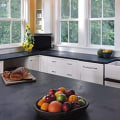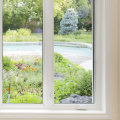When it comes to selecting the right window for your home, one of the most important considerations is the window's ENERGY STAR rating. ENERGY STAR ratings provide a measure of how well a product meets the requirements set out by the US Department of Energy, and they can help you make an informed decision when it comes to selecting the right windows for your home. But what do these ratings mean and how do different window types compare? In this article, we will explore the different ENERGY STAR ratings for different window types, and how these ratings can help you choose the right windows for your home. ENERGY STAR ratings are an important consideration when selecting windows for your home. These ratings provide an indication of the energy efficiency of a window, enabling you to make an informed decision when it comes to choosing the right window for your needs.
ENERGY STAR ratings are based on a window’s ability to reduce heating and cooling costs, improve comfort, and reduce environmental impacts. The ratings also take into account the window’s ability to reduce air leakage, solar heat gain, visible light transmittance, and other factors. Different window types have different ENERGY STAR ratings. For example, double-paned vinyl windows typically have higher ENERGY STAR ratings than single-paned aluminum windows.
Window frames also play a role in the overall rating, with metal frames generally having higher ratings than wooden frames. When comparing ENERGY STAR ratings between different window types, it’s important to consider the specific features and benefits of each type. For instance, double-paned vinyl windows offer greater insulation than single-paned aluminum windows, resulting in improved energy efficiency and lower energy bills. Additionally, metal frames are more durable and may be more suitable for areas that experience extreme temperatures or high winds.
It’s also important to consider the climate in which the window will be installed. Some windows may be better suited for certain climates than others. For instance, double-paned vinyl windows may be better suited for colder climates than single-paned aluminum windows due to their greater insulation capabilities. Similarly, metal frames may be more suitable for areas that experience extreme temperatures or high winds.
When choosing the right window for your home, it’s important to consider all of these factors. Be sure to compare ENERGY STAR ratings between different window types and select the one that best meets your needs and budget. Additionally, consider any local climate conditions that may influence your decision and always research any potential installation costs before making a purchase.
What are ENERGY STAR Ratings?
ENERGY STAR ratings are an important part of selecting windows, as they measure the energy efficiency of each window type.The ratings are determined by the U.S. Environmental Protection Agency (EPA) and are based on the window’s performance in multiple areas, including air leakage, design pressure, and condensation resistance. The ratings range from 0-100, with 100 being the most energy-efficient. The higher the rating, the better the window will perform in regards to energy efficiency.
ENERGY STAR ratings are important because they help you compare different windows and make an informed decision on which window type is best suited to your needs. In addition to helping you select the most efficient window type, ENERGY STAR ratings can also help you save money on heating and cooling costs. The higher the rating, the more cost savings you can expect over time. When shopping for windows, always look for the ENERGY STAR label to ensure you are selecting a highly efficient window that will help you save energy and money.
Comparing ENERGY STAR Ratings Between Different Window Types
When it comes to comparing ENERGY STAR ratings between different window types, it is important to consider the features and benefits of each window type.The ENERGY STAR rating system is a voluntary labeling program that measures the energy efficiency of various products, including windows. It is designed to help consumers identify the most energy-efficient windows on the market. When evaluating windows for energy efficiency, it is important to look at the type of frame material, the type of glass, and the type of insulation. For example, double-paned windows with low-emissivity (Low-E) glass and insulated frames can provide superior energy efficiency compared to single-paned windows with standard glass and non-insulated frames.
Additionally, the type of opening mechanism—whether it is casement, awning, or sliding—can also affect the energy efficiency of a window. When comparing ENERGY STAR ratings between different window types, it is important to consider the climate in which the window will be installed. Different climates require different levels of insulation and energy efficiency. For example, windows installed in cold climates need to be designed to minimize heat loss while those installed in warm climates need to be designed to maximize solar heat gain.
Additionally, certain window treatments can also impact energy efficiency. For example, blinds can help reduce solar heat gain in hot climates while drapes can help reduce heat loss in cold climates. In summary, when comparing ENERGY STAR ratings between different window types, it is important to consider the features and benefits of each window type, such as frame material, glass type, insulation type, opening mechanism, and climate. Additionally, certain window treatments can also affect energy efficiency.
Different Window Types and their ENERGY STAR Ratings
When it comes to choosing energy-efficient windows for your home, it’s important to understand the different ENERGY STAR ratings available. Different window types can have different ratings, and understanding them can help you make the best choice for your home.Single pane windows, for example, are the least energy-efficient type of window. They provide little to no insulation from outside temperatures, so they have a lower ENERGY STAR rating. Double-paned windows, on the other hand, have two sheets of glass that form an airtight seal between them. This helps prevent heat transfer, which makes them more energy-efficient than single-paned windows and gives them a higher ENERGY STAR rating.
Triple-paned windows take energy efficiency to the next level. These windows have three sheets of glass sealed together and filled with a gas like argon or krypton to further reduce heat transfer. This makes them even more energy-efficient than double-paned windows and gives them the highest ENERGY STAR rating. Low-E windows are also popular options for energy efficiency. These windows are coated with a special material that helps reflect infrared light, which keeps your home cooler in the summer and warmer in the winter.
Low-E windows can help reduce your energy costs and have a higher ENERGY STAR rating than traditional single- or double-paned windows. Finally, impact windows are made from strong, shatterproof glass that is designed to withstand strong winds and hail. These windows also have a higher ENERGY STAR rating than traditional single- or double-paned windows, as they provide additional insulation from outside temperatures.
Choosing the Right Window for Your Home
When it comes to selecting the right window for your home, it's important to consider the energy efficiency of each option as well as the climate and situation. ENERGY STAR ratings can provide an indication of the most energy-efficient windows, but there are other factors to consider when making your selection. Here are some tips on choosing the right window for your home:Climate and Location: Different types of windows are better suited to different climates and locations.For example, single and double hung windows work best in warmer climates, while triple pane windows are more effective in colder climates. Additionally, windows that face south or east are typically more energy efficient than those that face north or west.
Frame Materials:
The type of material used for the window frame can also affect energy efficiency. Vinyl frames are a good option for warmer climates, as they are good insulators and help keep the warm air out. For colder climates, wood frames can be a better choice, as they provide superior insulation.Glass Type:
The type of glass used in the window can also affect its energy efficiency.Low-e glass is a good option for keeping heat in during winter and out during summer. Additionally, Argon gas-filled windows are also an effective choice for keeping energy costs down.
Weather Stripping:
Weather stripping is an important factor to consider when selecting windows. It helps to keep air from entering or leaving through small gaps in the window frame, which can reduce energy costs. Additionally, it is important to ensure that the weather stripping is properly installed and maintained.Installation:
Proper installation is essential for ensuring that your windows are energy efficient.It is important to make sure that the windows are installed correctly and sealed tightly in order to prevent air leakage. Additionally, proper installation can help extend the life of your windows. Choosing the right window for your home is an important decision, and ENERGY STAR ratings can help you make an informed choice. Different window types have different ENERGY STAR ratings, so it’s important to understand the ratings for each type. By comparing the ENERGY STAR ratings of different window types, you can ensure that you choose the most energy-efficient window for your home.
Take the time to research and compare window options and their ENERGY STAR ratings to make sure you get the best window for your home. Now that you know more about ENERGY STAR ratings for windows, it’s time to start shopping. If you’re ready to make an informed decision on your window selection, use this article as a guide to find the best window for your needs.






